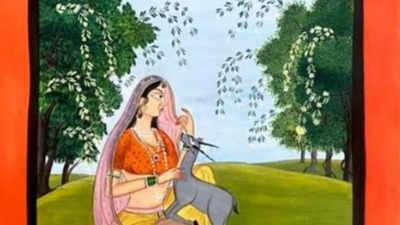Description

Disclaimer: Copyright infringement not intended.
Context
- The world famous 'Basohli Painting' - popular for its miniature art style from Kathua district has obtained the Geographical Indication (GI) Tag following approval by the National Bank for Agriculture and Rural Development Jammu.
What is a Geographical Indications (GI) tag?
- It is a form of Intellectual Property right that identifies goods originating from a specific geographical location and having distinct nature, quality and characteristics linked to that location.
- This is the first time in the history of GI registration that Jammu region got GI tag for handicrafts.
- The products which have obtained GI tagging included Basholi Pashmina Woolen Products (Kathua), Chikri Wood Craft (Rajouri), Bhaderwah Rajma (Doda), Mushkbudji Rice (Anantnag), Kaladi (Udhampur), Sulai Honey (Ramban), Anardana (Ramban), Ladakh Wood Carving (Ladakh).

About Basohli Painting
- The Pahari School of Art developed in the mountainous regions of Basohli, Kulu, Guler, Kangra, Jammu, and Garhwal between the 17th and 19th centuries.
- The first centre of the Pahari school materialized at Basohli with its own bold and flamboyant style.
Features
- Basohli, a simple town in the Jammu region, gave birth to a unique style of miniature paintings that witnessed a fusion of mythology and traditional folk art.
- It was under Sangram Pal (1635-1673) and later Kirpal Pal (1678-1693) that Basohli paintings flourished.
- Vaishnavism was adopted under Sangram Pal and hence the early paintings, specifically the Rasmanjari series, depict Krishna as the protagonist.
- The characteristic features of these paintings were the use of bright and bold colours like red, yellow, and blue in the borders, as well as for the generally flat background.
- The other distinguishing part was the facial features- a prominent nose and lotus-shaped eyes.
- The female figures can be categorised into three types according to their attire.
- The dressing style of both males and females resemble the clothes worn in the Mughal or Rajput courts.
- Depiction of flora was not unusual in Basohli paintings. The artists’ favourite was the bright red flowers of rhododendron.
- The most distinctive feature of these paintings was, however, the portrayal of jewellery- embossed white paint was used for pearls and the wing-case of beetles for emerald green.
- Two artists, Devidasa and Manaku were considered exceptionally gifted, and are supposed to have produced masterpieces.
- The ‘Gita Govinda series’ by Manaku holds great importance.
- The Basohli style continued until the mid-18th century and spread to other towns as well.
- The style never completely faded out and is believed to have inspired other centres of art.
|
PRACTICE QUESTION
Q) Which of the following statements with reference to Basholi Painting is/are correct?
a. It gave rise to the Pahari school of paintings.
b. The painting style faded in the mid-18th century.
c. Krishna is depicted as the protagonist.
- a and b
- b and c
- a and c
- None of the above
Answer: Option 2
|

https://timesofindia.indiatimes.com/city/jammu/kathuas-basohli-painting-gets-gi-tag/articleshow/99219407.cms?from=mdr















